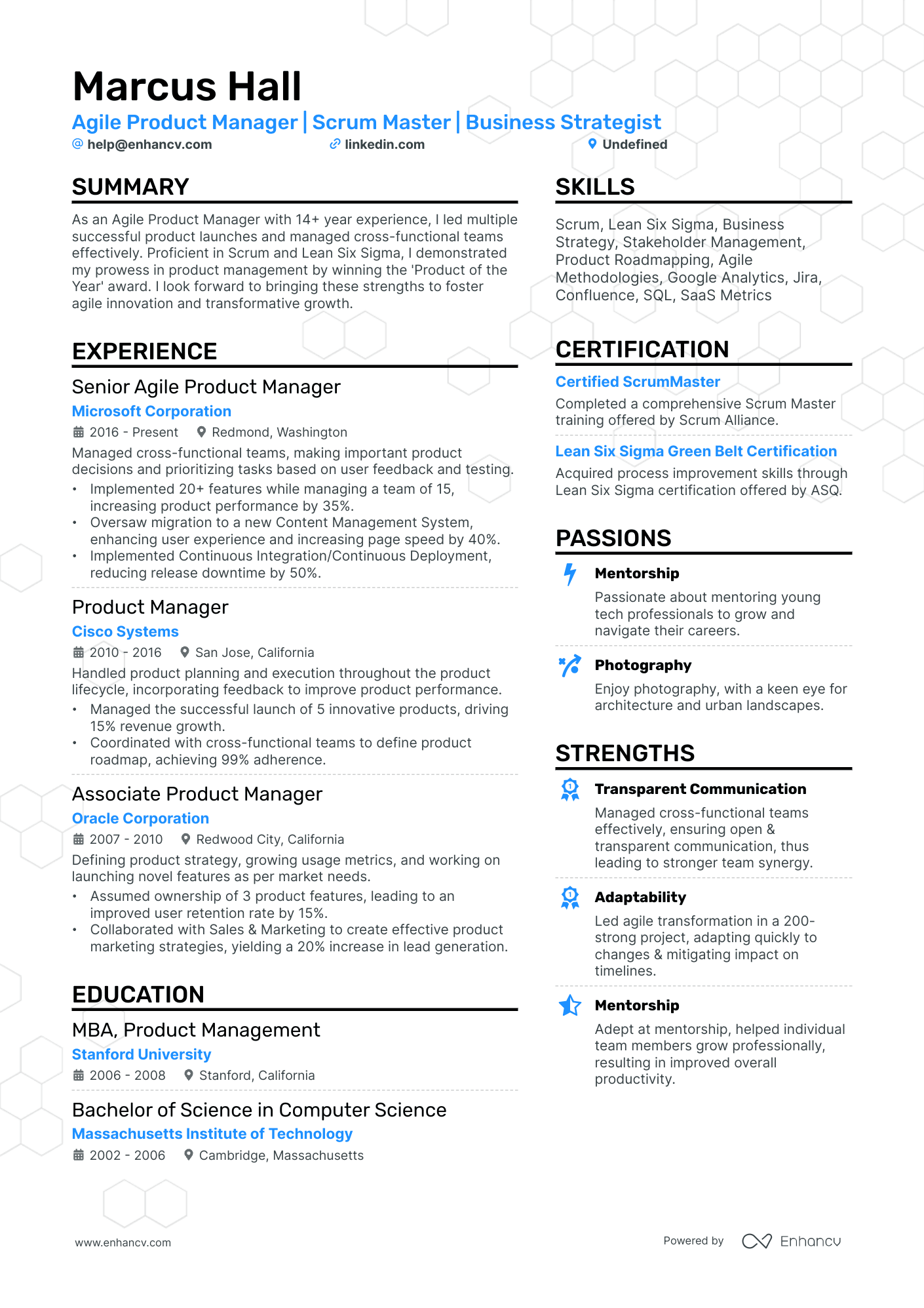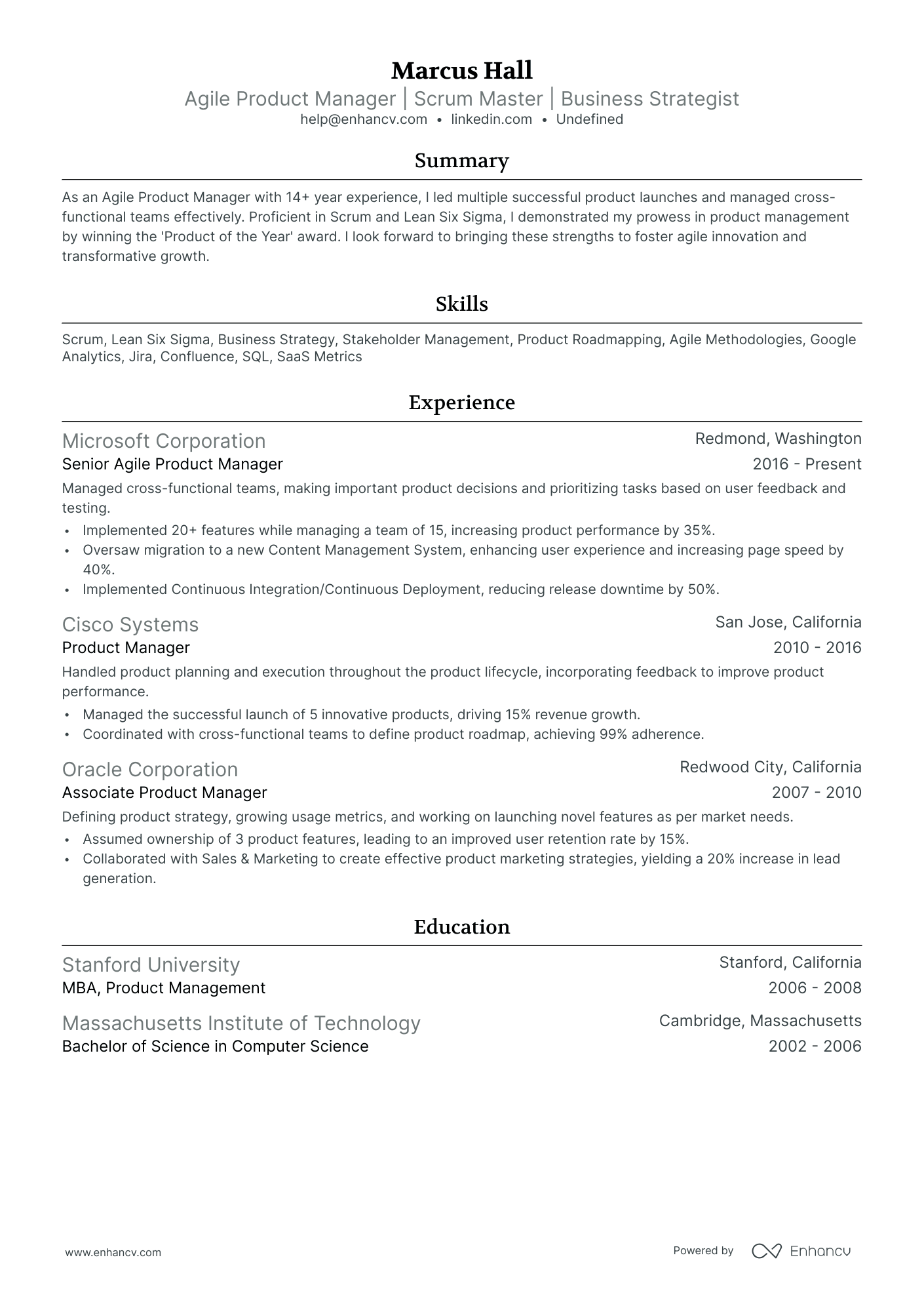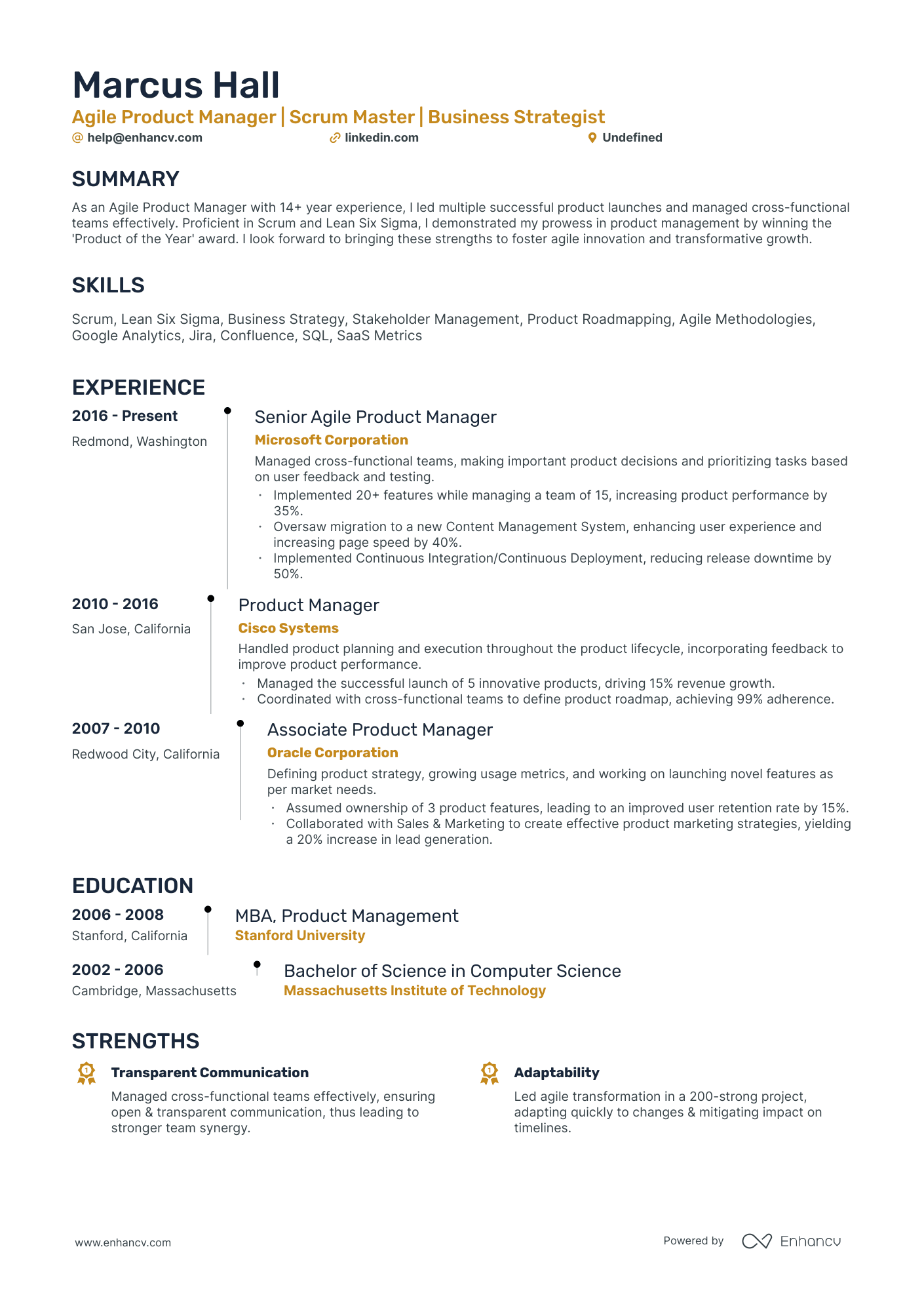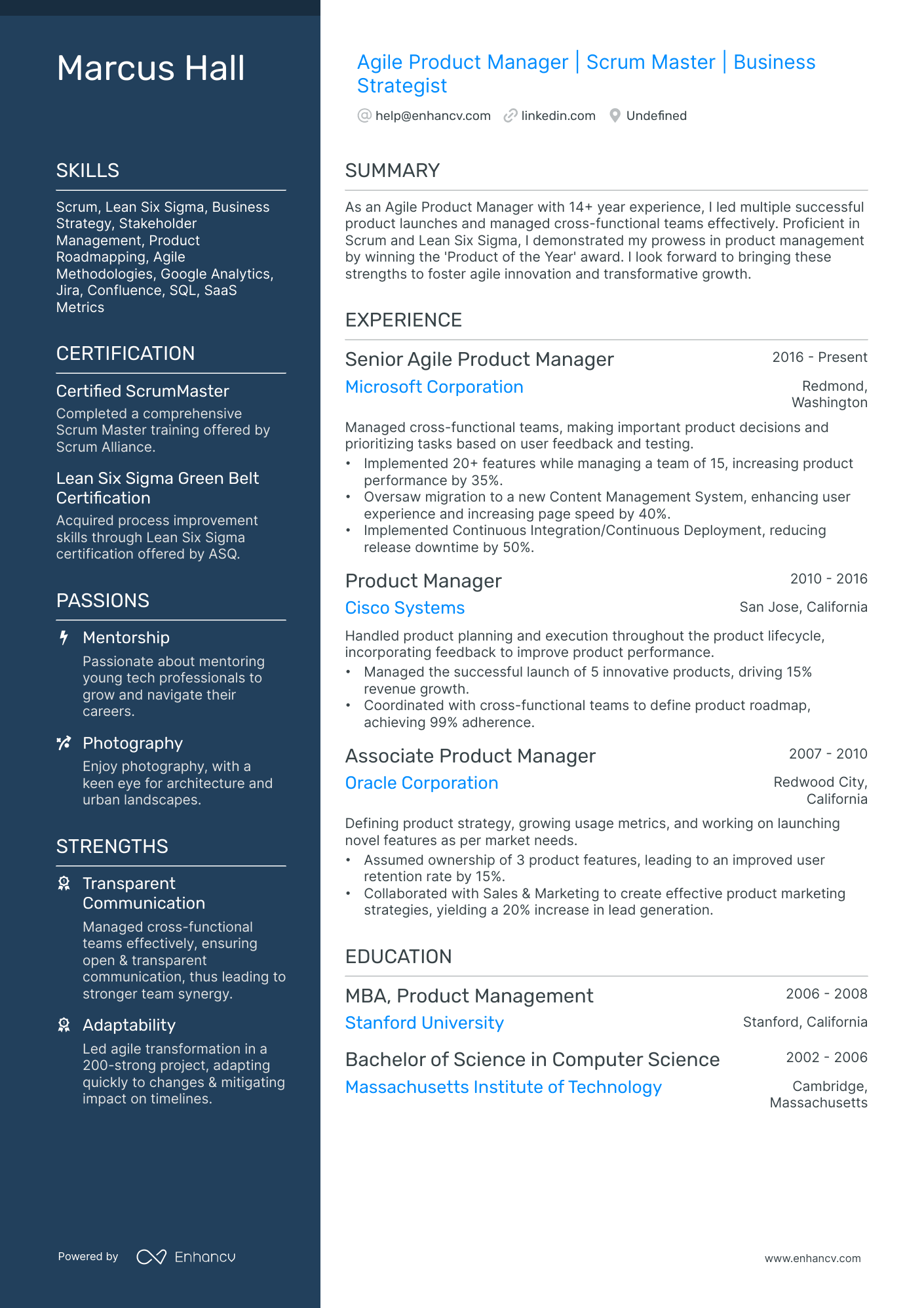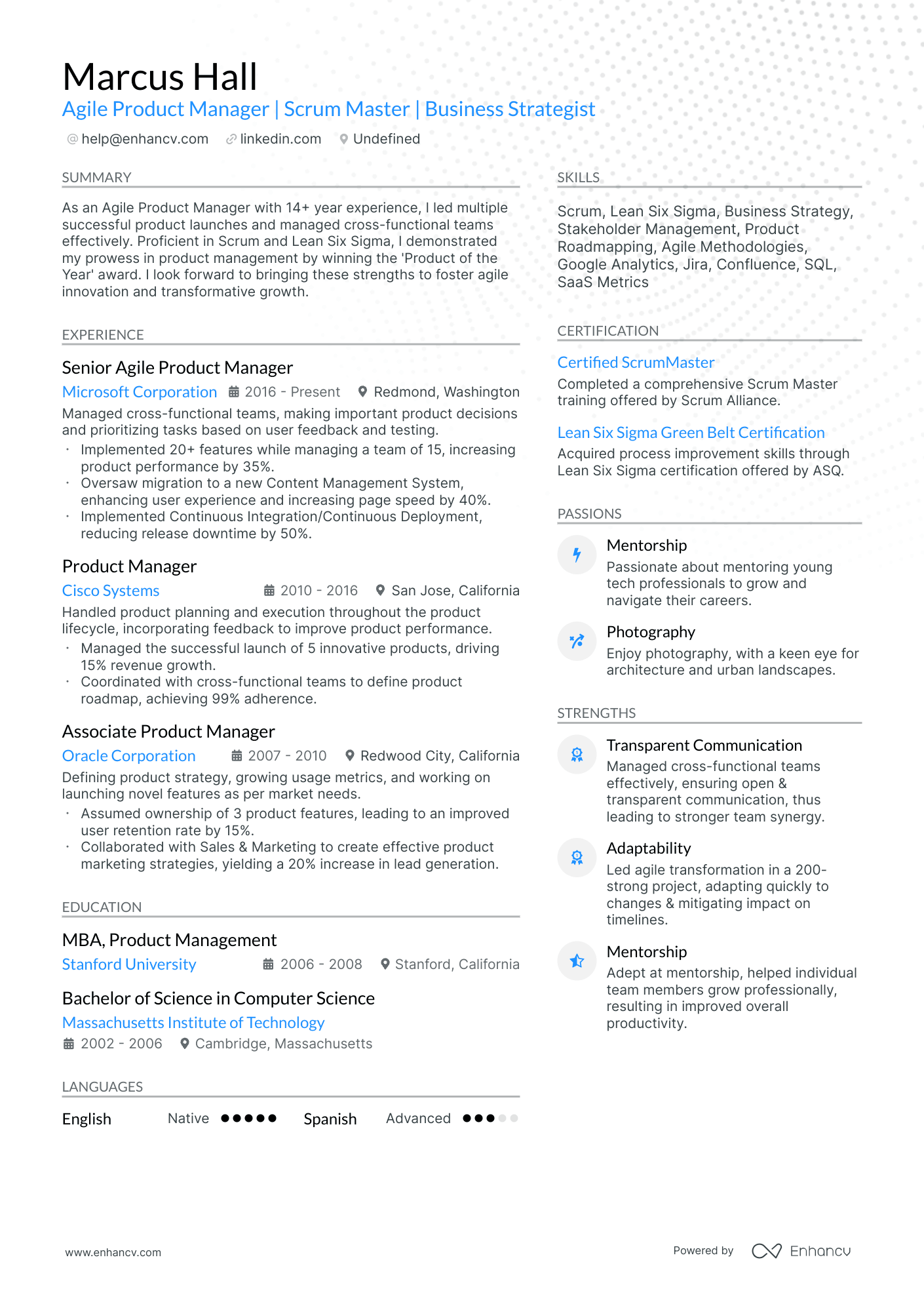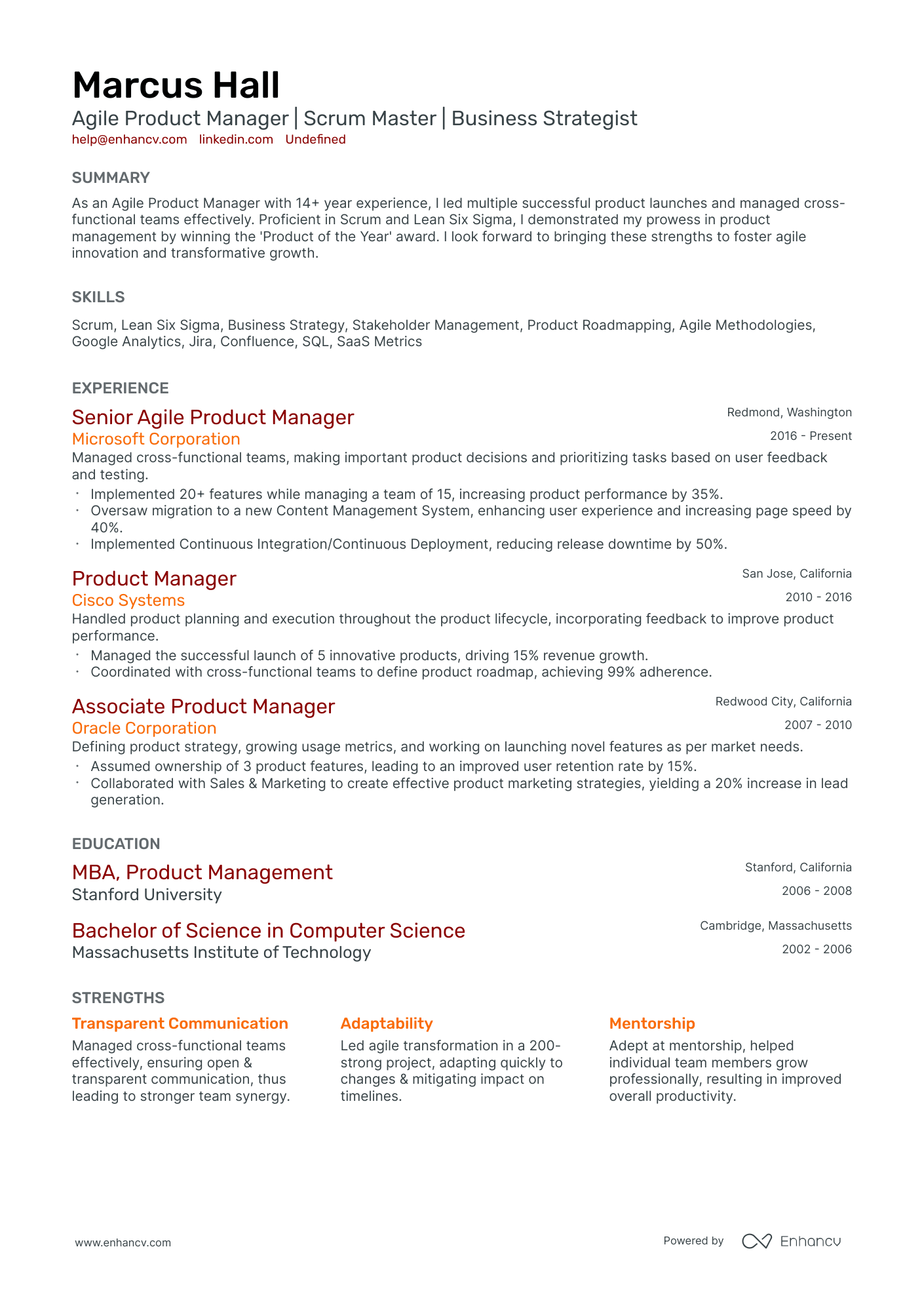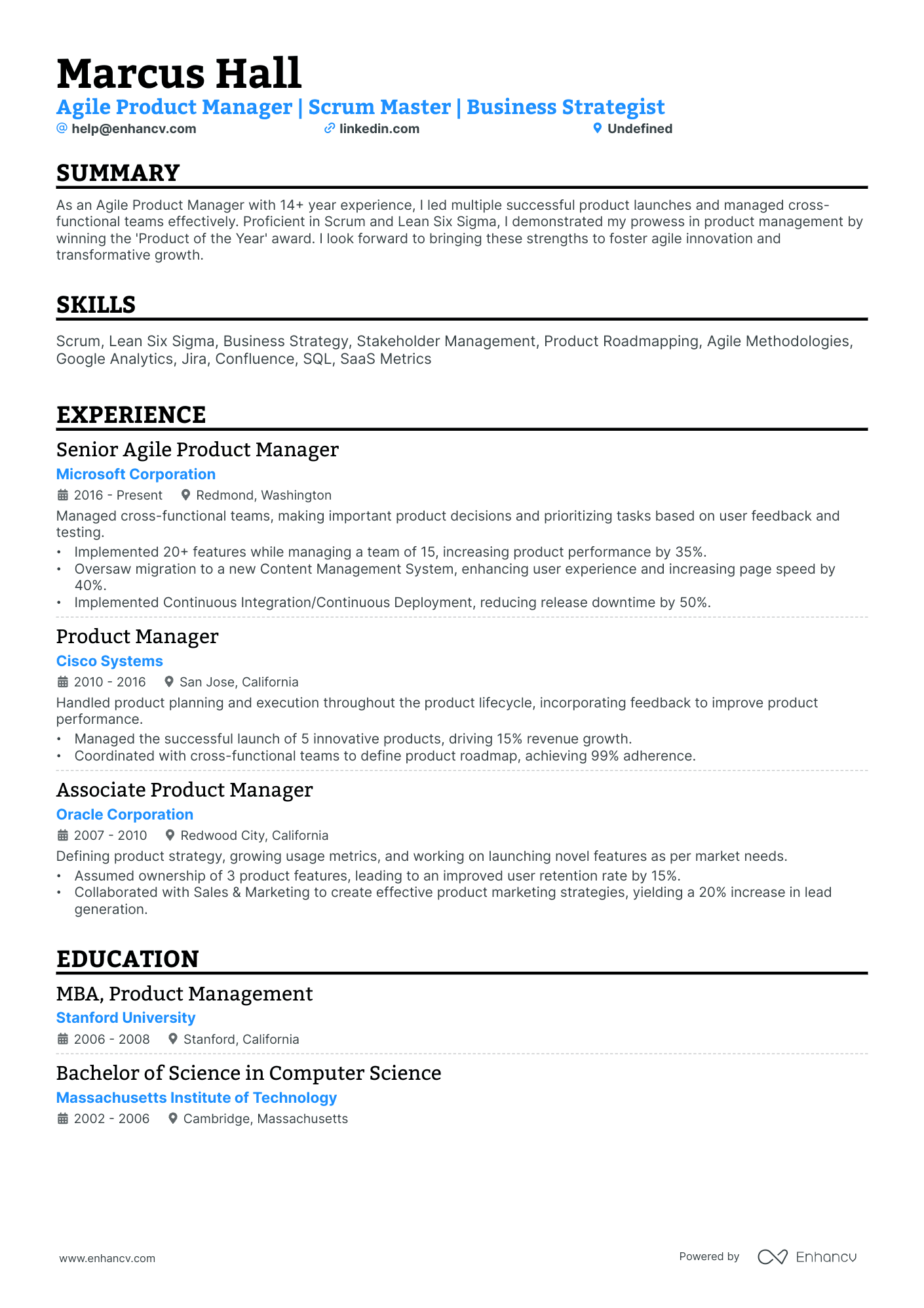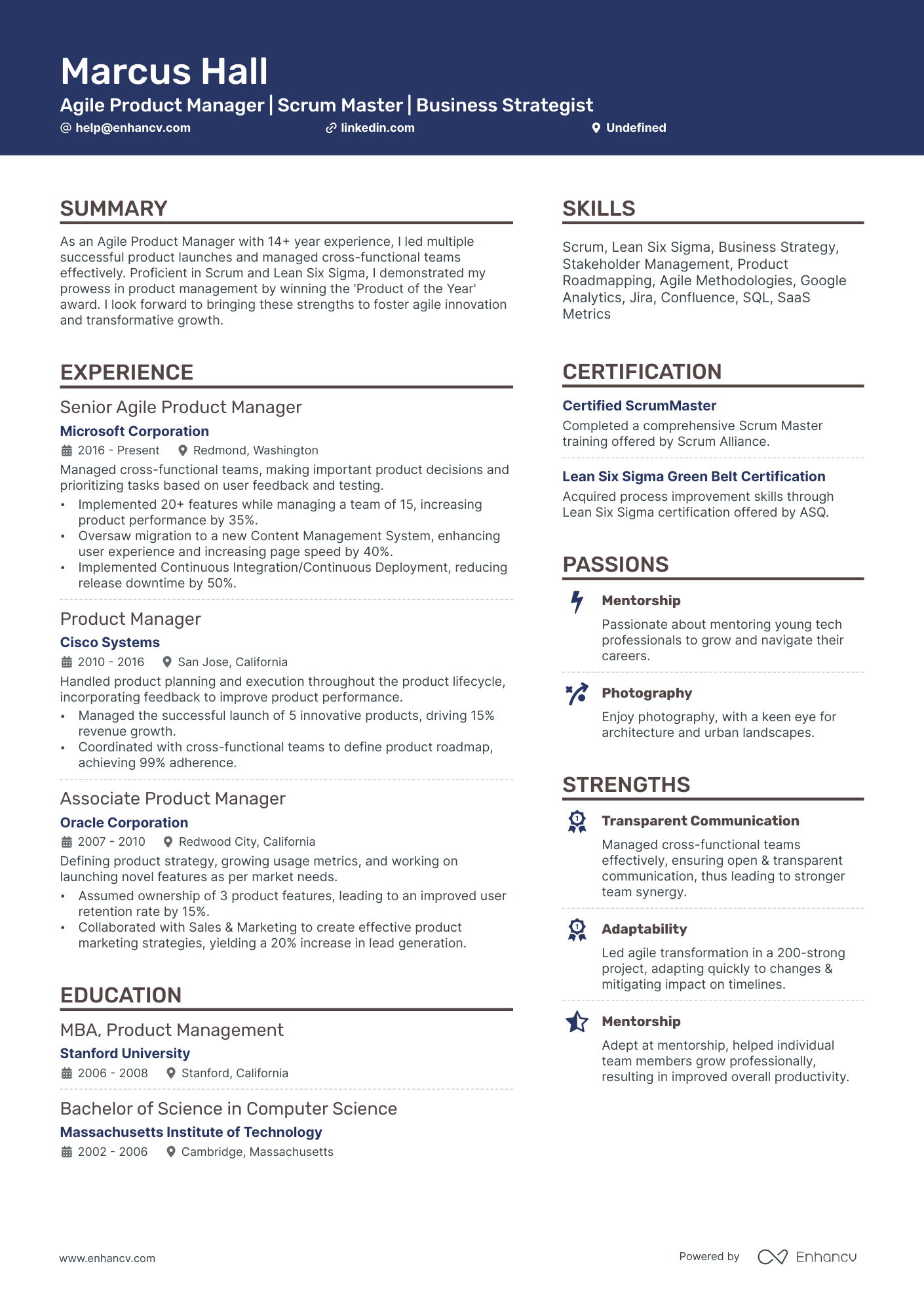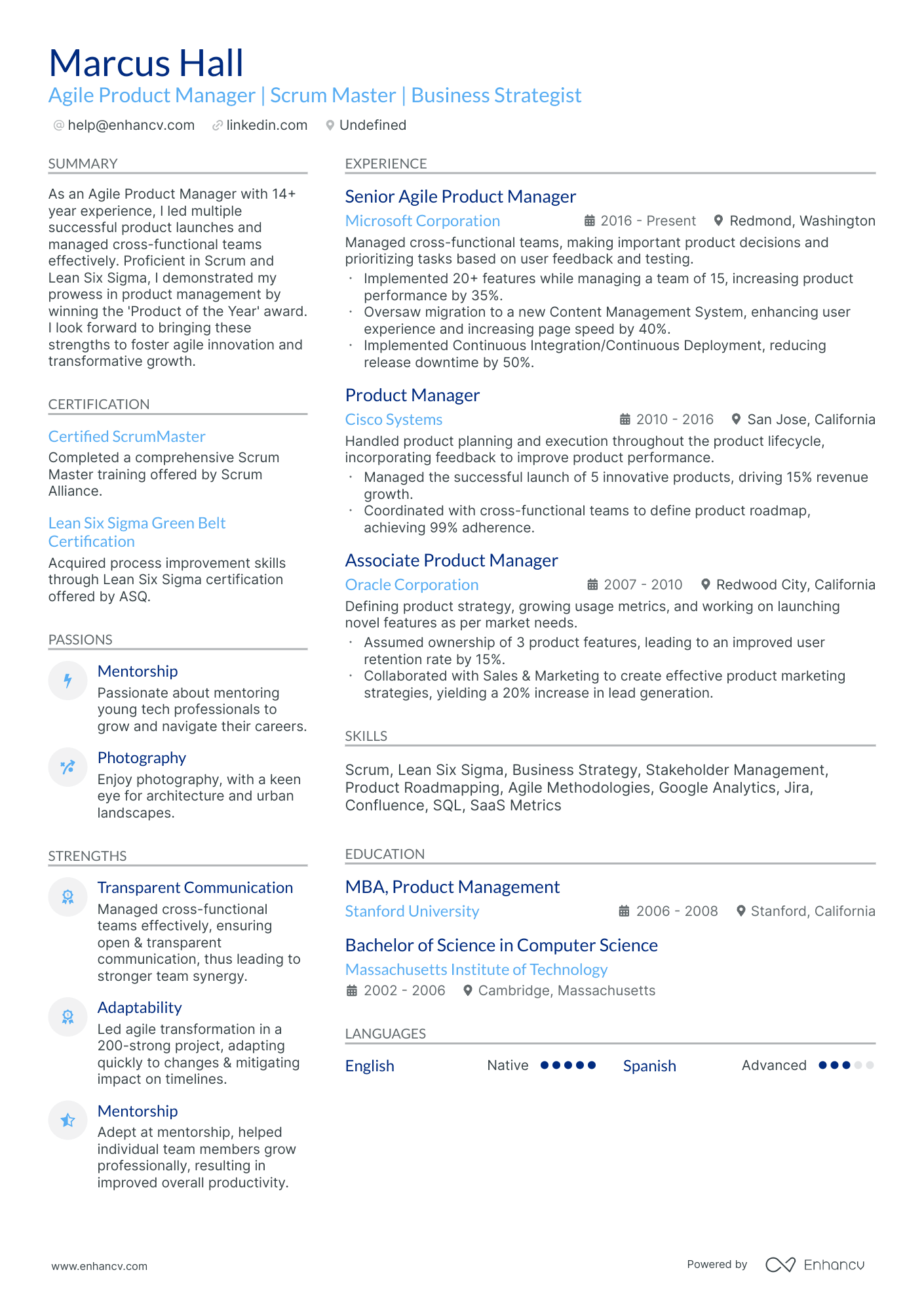One specific resume challenge faced by an Agile product manager is effectively showcasing their cross-functional leadership and capabilities in driving product development within the agile framework. Our guide can assist this by providing example bullet points and action verbs that demonstrate effective Agile leadership, along with insights on how to present important metrics or project outcomes.
Dive into this guide to uncover:
- Top-tier Agile product manager resume samples that have successfully landed candidates in leading companies.
- Strategies to direct recruiters' focus towards your standout experiences, notable achievements, and pivotal skills.
- Guidance on crafting resume sections that align closely with the vast majority of job specifications.
- Insights on harmonizing your Agile product manager technical prowess with your distinct personality, setting you apart from the competition.
Recommended reads:
Crafting an impeccable Agile product manager resume format in four steps
Your Agile product manager resume format should be both strategic and reader-friendly. Here's a concise guide to help you achieve that:
- Choose a format that aligns with the job's requirements. If your expertise is directly relevant, the reverse-chronological format is ideal. If you're focusing more on skills, consider the functional or hybrid formats.
- Header: Ensure it's populated with accurate contact details and any relevant portfolio links.
- Length: A one-page resume is standard, but if you have extensive experience, extending to two pages is acceptable.
- File type: To maintain formatting consistency, always opt for PDF.
Upload your resume
Drop your resume here or choose a file. PDF & DOCX only. Max 2MB file size.
Pro tip
Your resume will likely be processed by an Applicant Tracking System (ATS). Ensure your header, summary, or objective incorporates essential skills required for the role.
The five (plus) definite sections your resume for a Agile product manager job should include are:
- Header with your headline, contact details, and/or a preview of your work
- Summary (or objective) to pinpoint how your success aligns with the role
- Experience with bullets of your most relevant achievements in the field
- Skills to integrate vital job requirements (both technical and personal)
- Your further dedication to the field, showcased via relevant higher education and/or certifications
What recruiters want to see on your resume:
- Experience with Agile Methodology: Demonstrated understanding and experience with Agile practices, Scrum process, or other agile development methods.
- Product Ownership: Proven track record of owning and delivering innovative digital solutions from inception to launch.
- Stakeholder Management: Evidence of managing a range of stakeholders, including the ability to communicate clearly and negotiate effectively.
- Strategic Thinking: Ability to develop a long-term vision and strategy for the product, along with evidence of implementing it.
- Data-driven Decision Making: Proficiency in using data and metrics to test theories, confirm assumptions, and measure success.
Recommended reads:
The experience section of your Agile product manager resume: your professional journey
The experience section is your platform to narrate your professional story. Recruiters scrutinize this section to gauge your unique value proposition.
Here are five steps to craft a compelling experience section:
- Highlight relevant roles, including the company, role description, and tenure, supported by up to six bullet points per role.
- Emphasize tangible outcomes of your contributions, using quantifiable metrics where possible.
- Integrate positive feedback or endorsements to bolster your claims.
- Ensure verb tense consistency when detailing responsibilities.
- Summarize significant achievements relevant to each role.
Explore how seasoned Agile product manager professionals have crafted their experience sections to secure roles at industry-leading firms.
- Led cross-functional teams to successfully launch three major software products, resulting in a 15% increase in market share.
- Implemented Agile methodologies and Scrum framework, improving development cycle time by 20%.
- Collaborated with stakeholders to prioritize product features and define the product roadmap.
- Conducted user research and gathered customer feedback to drive product enhancements.
- Facilitated sprint planning meetings, daily stand-ups, and retrospectives to ensure timely delivery of high-quality software.
- Managed a team of developers and designers in delivering a mobile application that reached 1 million downloads within the first six months.
- Aligned product strategy with business goals, resulting in a 25% increase in revenue.
- Defined and communicated product vision to cross-functional teams, ensuring a clear understanding of project objectives.
- Collaborated with UX/UI designers to optimize user experience through iterative design and usability testing.
- Utilized data analytics to identify user behavior patterns and implement data-driven product improvements.
- Led the development of a SaaS platform, resulting in a 30% reduction in customer churn rate.
- Managed multiple concurrent projects, ensuring adherence to project timelines and budgets.
- Coordinated with engineering teams to prioritize feature development and resolve technical issues.
- Conducted market research and competitor analysis to identify new market opportunities and guide product strategy.
- Implemented A/B testing strategies, resulting in a 10% increase in conversion rate.
- Collaborated with stakeholders to define and prioritize product backlog items, ensuring alignment with business objectives.
- Facilitated sprint planning, backlog grooming, and daily stand-up meetings to drive effective collaboration within the development team.
- Implemented Agile best practices, including user story mapping and iterative development, resulting in a 20% improvement in time-to-market.
- Conducted market research and competitive analysis to identify market trends and inform product roadmap decisions.
- Managed customer feedback and incorporated it into product enhancements, resulting in a 15% increase in customer satisfaction.
- Developed and executed the go-to-market strategy for a new product line, resulting in a 40% increase in revenue within the first year.
- Collaborated with cross-functional teams to define and prioritize product features, ensuring alignment with customer needs.
- Led the adoption of DevOps practices, improving deployment frequency by 30% and reducing time to recover from failures.
- Conducted user acceptance testing and gathered user feedback to drive continuous product improvements.
- Implemented data-driven decision-making processes, leveraging analytics tools to monitor key product metrics and optimize performance.
- Managed the development of a B2B software application, resulting in a 25% increase in customer acquisition.
- Collaborated with sales and marketing teams to create effective product messaging and sales enablement materials.
- Conducted user research and usability testing to inform iterative product design and enhancements.
- Led cross-functional teams in delivering products within scope, budget, and timeline constraints.
- Utilized Agile metrics and reporting to track project progress and identify areas for improvement.
- Defined product vision and strategy, leading to a 30% increase in annual recurring revenue (ARR).
- Collaborated with UX designers to create intuitive user interfaces, resulting in a 20% reduction in user abandonment rate.
- Prioritized feature development based on market research and customer feedback, resulting in a 15% increase in customer satisfaction.
- Implemented Agile methodologies across multiple teams, improving collaboration and delivery efficiency.
- Conducted competitive analysis and market research to identify opportunities for product differentiation.
- Coordinated with stakeholders to define product requirements and translate them into actionable user stories.
- Managed the product backlog, ensuring its alignment with business objectives and customer needs.
- Facilitated sprint planning, backlog grooming, and retrospective meetings to drive continuous improvement within the development team.
- Collaborated with QA engineers to ensure high-quality software releases and timely bug resolution.
- Utilized market data and customer insights to guide product decision-making and enhance user experience.
- Led the development of a cloud-based platform, resulting in a 40% reduction in infrastructure costs.
- Managed cross-functional teams to deliver software solutions according to Agile best practices.
- Collaborated with stakeholders to define product roadmaps and prioritize feature development based on market demand.
- Implemented continuous integration and delivery processes, reducing time-to-market by 25%.
- Conducted user research and usability testing to drive iterative product improvements and enhance user satisfaction.
- Worked closely with engineering teams to define technical requirements and ensure successful product implementation.
- Developed pricing strategies that resulted in a 20% increase in average deal size.
- Conducted customer interviews and gathered feedback to identify pain points and drive product enhancements.
- Led the migration of legacy systems to a modern technology stack, improving system performance by 30%.
- Collaborated with marketing teams to develop effective go-to-market plans and support product launches.
Quantifying impact on your resume
<ul>
Addressing a lack of relevant Agile product manager experience
Even if you lack direct Agile product manager experience, you can still craft a compelling resume. Here's how:
- Highlight projects or publications that demonstrate your relevant skills or knowledge.
- Emphasize transferable skills, showcasing your adaptability and eagerness to learn.
- In your objective, outline your career aspirations and how they align with the company's goals.
- Consider a functional or hybrid resume format, focusing on skills over chronological experience.
Recommended reads:
Pro tip
The wording of your experience items should be with active, power verbs, instead of adjectives. Always be specific about each item you detail, and never overuse vague buzzwords. You weren't just "organized", but rather "Enhanced internal work processes to optimize operational management by 65%".
Highlighting your hard and soft skills on your Agile product manager resume
The skills section of your Agile product manager resume should showcase your capabilities that align with job requirements.
Your hard skills, or technical skills, demonstrate your proficiency with technological innovations and specific software. On the other hand, your soft skills illustrate how you'd excel in the workplace environment with personal attributes like resilience, negotiation, and organization.
For a well-rounded Agile product manager resume, it's essential to include both. Here's how to craft a standout skills section:
- Prioritize skills listed at the top of the job advert.
- Highlight unique skills you've honed over time.
- Choose soft skills that resonate with the company or department culture.
- Address essential job requirements by listing key skills for the Agile product manager role that haven't been mentioned elsewhere in your resume.
Check out our sample skill list for Agile product manager to get ideas on the most sought-after hard and soft skills in the industry.
Top skills for your Agile product manager resume:
JIRA
Trello
Confluence
Scrum
Kanban
Agile Frameworks
Product Roadmapping Tools
User Story Mapping
Analytics Tools (e.g., Google Analytics)
A/B Testing Tools
Communication
Leadership
Collaboration
Problem-Solving
Time Management
Adaptability
Critical Thinking
Negotiation
Empathy
Decision-Making
Pro tip
The placement of your skills section should align with its importance. If it's a showcase of your most significant strengths, position it prominently near the top of your resume.
Choosing the right certifications and education for your Agile product manager resume
Your education section can highlight skills and experiences perfect for the job.
- List college or university degrees with the school name and dates.
- If you're still studying, mention your expected graduation date.
- Think twice before adding unrelated degrees. Space on your resume is precious.
- Discuss educational achievements if they boost your job relevance.
There are many certifications out there. Which ones should you include?
- List your main degree in a separate section with the school name and dates.
- Only add certifications that highlight your skills and experience.
- Place unique or recent certifications near the top.
- Add a brief description to certifications if it helps show your skills.
Remember, it's not about quantity but relevance.
Best certifications to list on your resume
Pro tip
The reputation of the institution or organization granting your certification or degree can bolster your credibility. Prioritize recognized and respected credentials.
Recommended reads:
Crafting the Agile product manager resume summary or objective: a blend of achievements, aspirations, and uniqueness
Whether you opt for a resume summary or objective depends on your career trajectory.
- If you have a rich tapestry of relevant achievements, a resume summary can spotlight these accomplishments.
- If you're relatively new or transitioning, a resume objective can articulate your aspirations and how they align with the role.
Regardless of your choice, this section should encapsulate your unique value proposition, blending your technical and interpersonal strengths.
Resume summary and objective examples for a Agile product manager resume
Extra sections to include in your Agile product manager resume
What should you do if you happen to have some space left on your resume, and want to highlight other aspects of your profile that you deem are relevant to the role?
Add to your Agile product manager resume some of these personal and professional sections:
- Passions/Interests - to detail how you spend both your personal and professional time, invested in various hobbies;
- Awards - to present those niche accolades that make your experience unique;
- Publications - an excellent choice for professionals, who have just graduated from university or are used to a more academic setting;
- < a href="https://enhancv.com/blog/volunteering-on-resume/"> Volunteering - your footprint within your local (or national/ international) community.
Key takeaways
- A clear resume layout helps present your info well.
- Use all main resume sections to show how you fit the job.
- Detail specific skills or tasks and their impact.
- Show your personality through interests or hobbies.
- List certifications to back up your technical skills.
